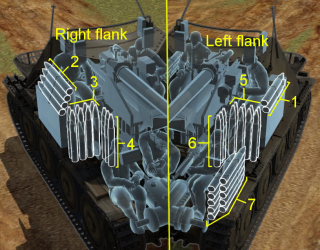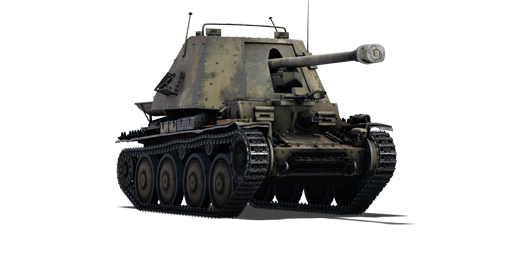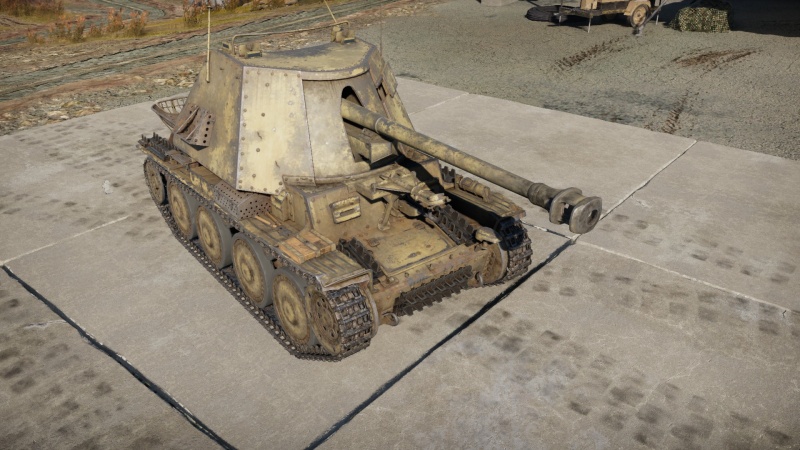Marder III H
| This page is about the German tank destroyer Marder III H. For other uses, see LT-38 (Family). |
Contents
Description
The PaK40/3 auf Sfl.38 Ausf. H (or Marder III H) is a rank II German tank destroyer with a battle rating of 3.0 (AB/RB/SB). It was introduced in Update 1.47 "Big Guns".
The Marder III H is a step above the basic Marder III. As it is in Germany's open - top tank destroyer line, it's calling card is its superb firepower; in fact, it has the most powerful gun for the battle rating 2.0 - 3.0 - 4.0 range - APCBC is almost always enough to penetrate and destroy any tank on the battlefield, and with APCR, it has the highest penetration of any tank for its battle rating range - even at battle rating 5.0 your gun will remain competitive.
The Marder III Ausf. H mounts a 75 mm gun slightly surpassing those on the late Panzer IV's, thus its only disadvantages are its weak armour and its open encasement.
Being a modified Pz.38(t) tank, it is one of the more mobile of the German tanks - nearly matching some Russian tanks. It has a better gun close-range wise and has better armour coverage, being curved to the sides, unlike the earlier Marder III.
General info
Survivability and armour
Armour type:
- Rolled homogeneous armour
| Armour | Front (Slope angle) | Sides (Slope angle) | Rear | Roof |
|---|---|---|---|---|
| Hull | 50 mm (19°) Front plate 12 mm (74°) Front glacis 50 mm (13°) Lower glacis |
16 mm Upper 15 mm Lower |
15 mm | 12 mm |
| Turret | 11 + 8 mm (31°) | 11 mm (8-9°) | N/A | N/A |
Note:
- Belly armour is 15 mm thick.
Mobility
| Game Mode | Max Speed (km/h) | Weight (tons) | Engine power (horsepower) | Power-to-weight ratio (hp/ton) | |||
|---|---|---|---|---|---|---|---|
| Forward | Reverse | Stock | Upgraded | Stock | Upgraded | ||
| Arcade | 49 | 7 | 11 | 213 | 286 | 19.36 | 26 |
| Realistic | 45 | 7 | 133 | 150 | 12.09 | 13.64 | |
Modifications and economy
Always go for "Parts" and "FPE" first to increase the vehicle's survivability. The stock shell is quite effective, so the Ml.Gr 38B HEAT shell and PzGr 40 APCR shell are not priorities either. Instead, focus on mobility upgrades and the Horizontal Drive modification. After that, the order of research will be determined by personal preference.
Armaments
Main armament
| 75 mm PaK40/3 L46 | Turret rotation speed (°/s) | Reloading rate (seconds) | |||||||||||
|---|---|---|---|---|---|---|---|---|---|---|---|---|---|
| Mode | Capacity | Vertical | Horizontal | Stabilizer | Stock | Upgraded | Full | Expert | Aced | Stock | Full | Expert | Aced |
| Arcade | 38 | ±9° | ±28° | N/A | 10.57 | 14.63 | 17.76 | 19.63 | 20.89 | 7.67 | 6.79 | 6.25 | 5.90 |
| Realistic | 7.14 | 8.40 | 10.20 | 11.28 | 12.00 | ||||||||
Ammunition
| Penetration statistics | |||||||
|---|---|---|---|---|---|---|---|
| Ammunition | Type of warhead |
Penetration @ 0° Angle of Attack (mm) | |||||
| 10 m | 100 m | 500 m | 1,000 m | 1,500 m | 2,000 m | ||
| PzGr 39 | APCBC | 151 | 148 | 135 | 121 | 108 | 96 |
| Hl.Gr 38B | HEAT | 80 | 80 | 80 | 80 | 80 | 80 |
| PzGr 40 | APCR | 182 | 177 | 159 | 140 | 122 | 107 |
| Sprgr. 34 | HE | 10 | 10 | 10 | 10 | 10 | 10 |
| Shell details | |||||||||
|---|---|---|---|---|---|---|---|---|---|
| Ammunition | Type of warhead |
Velocity (m/s) |
Projectile Mass (kg) |
Fuse delay (m) |
Fuse sensitivity (mm) |
Explosive Mass (TNT equivalent) (g) |
Ricochet | ||
| 0% | 50% | 100% | |||||||
| PzGr 39 | APCBC | 792 | 6.8 | 1.2 | 14 | 28.9 | 48° | 63° | 71° |
| Hl.Gr 38B | HEAT | 450 | 4.4 | 0.05 | 0.1 | 872.1 | 62° | 69° | 73° |
| PzGr 40 | APCR | 990 | 4.1 | N/A | N/A | N/A | 66° | 70° | 72° |
| Sprgr. 34 | HE | 550 | 5.74 | 0 | 0.1 | 686 | 79° | 80° | 81° |
| Smoke shell characteristics | ||||||
|---|---|---|---|---|---|---|
| Ammunition | Velocity (m/s) |
Projectile Mass (kg) |
Screen radius (m) |
Screen deploy time (s) |
Screen hold time (s) |
Explosive Mass (TNT equivalent) (g) |
| K.Gr.Rot Nb. | 540 | 6.2 | 13 | 5 | 20 | 50 |
Ammo racks

| Full ammo |
1st rack empty |
2nd rack empty |
3rd rack empty |
4th rack empty |
5th rack empty |
6th rack empty |
7th rack empty |
Visual discrepancy |
|---|---|---|---|---|---|---|---|---|
| 38 | 37 (+1) | 33 (+5) | 25 (+13) | 22 (+16) | 14 (+24) | 11 (+27) | 1 (+37) | No |
- Gun shield empty (racks 1 & 2 emptied): 33 (+5).
Machine guns
| 7.92 mm MG37(t) | ||||
|---|---|---|---|---|
| Mount | Capacity (Belt) | Fire rate | Vertical | Horizontal |
| Hull | 1,200 (200) | 769 | ±10° | ±10° |
Usage in battles
Since you are an unprotected tank from behind, try to be as far from the action as possible. If getting close to enemy tanks cannot be prevented (Urban maps, Allied retreat etc), then try to hide at least a part of your hull against a wall or rock.
Use the horizontal range of the Marder III H as much as possible: it has excellent gun traverse for a turretless SPG. This tank destroyer can be penetrated easily; it has next to no armour at its battle rating. Keep close to other tanks to prevent this in urban maps, and stay close to cover in other maps. Also, be careful when being targeted by Artillery; one close hit on your rear and you can be destroyed by shrapnel. Another important aspect to take into account is the fact that ammunition is stored in the nearly unarmoured gun shield - nearly any vehicle in the game - with the notable exception of the GAZ-AAA (4M) - can penetrate this tank with ease. To get Ammunition out of the turret, bring fewer shells, leaving the "turret" basically empty - 33 shells is more than enough. Another fact to consider is that nearly all shells will over penetrate the "turret", with no damage, a crewman knocked out or 2.
The Marder III H's main APCBC shell, the PzGr 39, is good enough against most standard medium tank models like the M4 Sherman and T-34 from a frontal and slightly angled perspective. However, the penetration performance against sloped armour is only just enough for these circumstances, and extreme angling beyond a 60° angle of attack on those tanks' part can bounce rounds heading towards their front glacis. This makes up-armoured models like the T-34E and T-34E STZ particularly dangerous as they can defeat the APCBC shell's sloped performance at even slight angles. The T-34E presents itself an enhanced side armour that can bounce shots while the T-34E STZ features enhanced front armour to bounce shots, so be sure to distinguish the two models for a better understanding on where to aim.
Pros and cons
Pros:
- Outstanding gun for its rank
- Armour that protects the crew from MG fire, but thin enough to allow normal AP rounds to over-penetrate
- Fairly small tank destroyer can hide behind most obstacles
- Good gun depression
- Excellent horizontal arc of 30°, that allows hiding easily the tank
- Amazing penetration with APCR ammunition
Cons:
- Vulnerable to overpressure (HE rounds)
- Not fully enclosed (exposed crew)
- Poor gun elevation
- High penetration power makes shells overpenetrate most light tanks it faces
History
Development
After the start of Operation Barbarossa, the Wehrmacht found a very dire problem of the lack of a mobile anti-tank system and adequate anti-tank weapons, especially after the appearance of the Soviet T-34 and KV-1 tanks. The only mass-issued anti-tank was the 37 mm Pak 36 and the only mobile anti-tank system widely used was the Panzerjäger I with the Czech 47 mm anti-tank gun. Modifications to current vehicles in service was done to put more self-propelled anti-tank weapons into service, which created the Marder I from the French Lorraine, the Marder II from the Panzer IIs, and the Marder III from the Czech Panzer 38(t).
Specifications
The Marder III, with the rest of the Marder series, gave Germany forces a self-propelled gun mounting a better gun than what was available on German tanks, such as the 75 mm Pak 40 or captured Soviet 76.2 mm guns chambered for the Pak 40 ammo. All of the Marders share a lack of armour for the crew, the top and rear of the vehicle is left exposed to mortar, shrapnel, or infantry weapons. This weakness is mitigated with the fact that the Marders is supposed to be anti-tank motor carriages that are to ambush incoming enemy tanks.
The Marder III Ausf. H uses the Panzer 38(t) as it was a design going obsolete, and new large German anti-tank weapons were being produced, so they mounted these guns onto the Panzer 38(t) first. The finished self-propelled mount had a higher silhouette than the Panzer 38(t), which left it more vulnerable, but had a 75 mm Pak 40 gun and withhold 38 rounds in the vehicle. A machine gun on the hull was retained for anti-infantry purposes.
The Marder III Ausf. H predecessor, simply named as the Marder III mounted a rechambered 76.2 gun instead of a Pak 40. Another variant created, the Ausf. M, featured a lower silhouette and a better-sloped armour and fighting compartment, despite only holding 27 rounds for the mounted Pak 40. A total of 3,472 Marder IIIs and its version was created or converted from Panzer 38(t) during its production life.
Combat usage
The Marder III Ausf. H fought on all fronts of the war, being produced from 1942 to 1945, with 450 Marder III Ausf. H with the Pak 40 converted and produced. Using the tested design of the Panzer 38(t), the Marder III experienced a reliable mechanical history and has a gun that could take out most allied tanks in the war. The vulnerability to the crew due to lack of armour was its most pressing issue, with only a front shield plate at most 15 mm thick and side plates that can't enclose the crew. This makes it as very poor assault vehicles or tank substitutes as the open top could allow infantry to easily kill the crew from hidden areas, despite that, it is sometimes repurposed to this role to the chagrin of the crew.
As its production was underway, Germany already had a few self-propelled assault weapons being produced such as the StuG III that could have the same anti-tank capabilities, yet was fully armoured, enclosing the crew inadequate armour. This obvious advantage over the open Marder series encouraged the development of a new kind of tank destroyer from the Panzer 38(t) with better armour, which will eventually create the Jagdpanzer 38(t). Despite that, the Marders continued to serve to the end of the war.
In-game description
An antitank vehicle designed by Alkett. The prototype was built in June, 1942. It was produced from November, 1942 to April, 1943 at the BMM factory. The Marder II Ausf.H was also rebuilt from damaged tanks at the Wehrmacht factory in Prilougi using cabins obtained from BMM.
Marder IIIs were used actively on all fronts of World War II. Most of them were used on the Eastern Front.
A total of 613 Marder III Ausf.H tank destroyers were produced.
Media
- Skins
See also
Links to the articles on the War Thunder Wiki that you think will be useful for the reader, for example:
- reference to the series of the vehicles;
- links to approximate analogues of other nations and research trees.
External links
Paste links to sources and external resources, such as:
- topic on the official game forum;
- other literature.
| Germany tank destroyers | |
|---|---|
| Pz. I Derivatives | Panzerjäger I |
| Pz. II Derivatives | 15cm sIG 33 B Sfl |
| Pz. 38(t) Derivatives | Marder III · Marder III H · Jagdpanzer 38(t) |
| Pz. III Derivatives | StuG III A · StuG III F · StuG III G · StuH 42 G |
| Pz. IV Derivatives | Jagdpanzer IV · Panzer IV/70(A) · Panzer IV/70(V) · Dicker Max · Nashorn · Brummbär · VFW |
| Pz. V Derivatives | Jagdpanther G1 · Bfw. Jagdpanther G1 |
| Pz. VI Derivatives | Sturer Emil · Elefant · Ferdinand · 38 cm Sturmmörser · Jagdtiger |
| Wheeled/Half-track | 8,8 cm Flak 37 Sfl. · Sd.Kfz.251/9 · Sd.Kfz.251/10 · Sd.Kfz.251/22 · Sd.Kfz.234/3 · Sd.Kfz.234/4 · 15 cm Pz.W.42 |
| ATGM Carrier | RakJPz 2 · RakJPz 2 (HOT) · Wiesel 1A2 |
| Other | Waffenträger · M109G · JPz 4-5 · Raketenautomat · VT1-2 |





